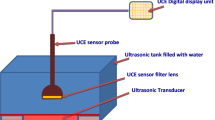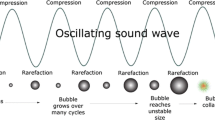Abstract
Ultrasound technology is widely studied for advanced manufacturing. In the present paper, measurement, analysis of ultrasound-induced cavitation and characterization of energy distribution in horn-type ultrasonic probe (20 kHz) are presented. Mapping was made with variation in ultrasound power (USP) [150–500 W], using ultrasonic cavitation energy (UCE) sensor in a cylindrical process vessel of two capacities (1 and 3 L) and energy profiles plotted as 3D graphical representation for different conditions (dp, Hs, Vs) applicable to any given generic process. The results indicate maximum UCE at center of the vessel, coinciding with ultrasound probe axis. There is about 8–16.7% reduction of UCE due to the presence of leather for 3-L and 1-L beaker for various USPs. However, average UCE increases with an increase in USP 150 to 500 W for 3-L beaker, with and without leather. Ultrasound absorption coefficient (α) in goat leather has been calculated to be in the range of 9.5–10 and 19.5–10.4 (m2) Sabins, respectively, for 3-L and 1-L beaker experiments. In 1-L beaker, distance from US probe tip to leather surface at d = 3 and 4 cm provides better UCE: 8.8 and 6.3 W/cm2, respectively, and corresponding better enhancement factor in %Exhaustion: 32.3 and 28.7 in leather dyeing with ultrasound, compared to control. Prediction model of UCE from ultrasound power density, independent of configuration and regression model for various USPs was proposed, found to be comparable with experimental values. This analysis could be useful in design and development of ultrasound system for scale-up in a broader perspective and for leather in specific.













Similar content being viewed by others
Availability of Data and Material
All data generated or analyzed during this study are included in this published article.
References
K.S. Suslick, Science 147, 1439 (1990)
F. Contamine, F. Faid, A.M. Wilhelm, J. Berlan, H. Delmas, Chem. Engg. Sci. 49(24B), 5865 (1994)
V. Sivakumar, G. Swaminathan, P.G. Rao, T. Ramasami, Chem. Eng. Process 47(12), 2076 (2008)
A. Pantano, D. Cerniglia, Appl. Phys. A 91, 521 (2008)
V. Sivakumar, P.G. Rao, J. Cleaner Prod. 9(1), 25 (2001)
V. Sivakumar, G. Swaminathan, P.G. Rao, T. Ramasami, Ultrason. Sonochem. 16(1), 116 (2009)
V. Sivakumar, J. Am. Leather. Chem. Assoc. 115(7), 239 (2020)
V. Sivakumar, G. Swaminathan G, P.G. Rao, T. Ramasami T (2009), Int. J. Adv. Manuf Technol. 45, 41.
V. Sivakumar, P.G. Rao, Ultrason. Sonochem. 10(2), 85 (2003)
V. Sivakumar, P.G. Rao, Environ. Sci. Technol. 38(5), 1616 (2004)
A.J. Mortimer, B.J. Trollope, E.J. Villeneuve, O.Z. Roy, Ultrasonics 26, 348 (1988)
I. Lenart, D. Ausländer, Ultrasonics 18, 216 (1980)
R. Kumar, Indian Chem. Engr. J. 36(1–2), 3 (1994)
D.V. Prasad Naidu, R. Rajan, R. Kumar, K.S. Gandhi, V.H. Arakeri, S. Chanrasekaran 1994, Chem. Engg. Sci. 49, 877.
R. Rajan, R. Kumar, K.S. Gandhi, Chem. Engg. Sci. 53(2), 255 (1998)
V.S. Moholkar, S.P. Sable, A.B. Pandit, AIChE J. 46, 684 (2000)
F.J. Keil, S. Dähnke, Hung. J. Ind. Chem. 25, 71 (1997)
S. Dähnke, K.M. Swamy, F.J. Keil, 6(4), 221 (1999).
Pérez-Sánchez, J.A. Segura., C. Rubio-Gonzalez,., L.A. Baldenegro-Pérez, J.A. Soto-Cajiga, Sensors and Actuators A, Physical 311, 112035 (2020).
H. Peng, P. Zhu, P. Lu, Sens. Actuator A Phys. 263, 744 (2017)
K.S.F. Lew, E. Klaseboer, B.C. Khoo, Sens. Actuator A Phys. 1331, 161 (2007)
L. Gaete-Garretón, Y. Vargas-Hernández, S. Pino-Dubreuil, F. Sens. Actuator A Phys. 37–38, 410 (1993)
V. Sivakumar, G. Swaminathan, P.G. Rao, C. Muralidharan, A.B. Mandal, T. Ramasami, Ultrason. Sonochem. 17(6), 1054 (2010)
H. Xu, J. Tu, F. Niu, P. Yang, Appl. Acoust. 101(2016), 179–184 (2016)
L. Escobar-Alarcón, E. Velarde Granados, D.A. Solís-Casados, O. Olea-Mejía, M. Espinosa-Pesqueira, E. Haro-Poniatowski, Appl. Phys. A 122, 433 (2016)
S. Chen, A. Sabato, C. Niezrecki, P. Avitabile, T. Huber, J. Sound Vib. 432, 33 (2018)
J. Frohly, S. Labouret, C. Bruneel, I. Looten-Baquet, R. Torguet, J. Acoust. Soc. Am. 108, 2012 (2000)
V. Sivakumar, P.G. Rao, J. Am. Leather Chem. Assoc. 98(6), 230 (2003)
M Vorlander, Auralization: Fundamentals of acoustics, modelling, simulation, algorithms and acoustic virtual reality, 2nd Edn. (Springer, Dordrecht, 2007), pp. 307.
D. Davis, Carolyn, D (Second Edition, Focal Press, USA, Sound System Engineering, 1997)
Acknowledgements
V.S thanks and is indebted to the Department of Science Technology (DST)—Science and Engineering Research Board (SERB), New Delhi, GoI, India, for the research grant and fund provided for this project Ref. No. EMR/2015/000202. He also thanks CSIR-CLRI for the support. He is grateful to all his guides and mentors for their encouragement and motivation. He also thanks the anonymous reviewers for the manuscript for their valuable comments in improving the quality of the paper.
Funding
This study was funded by the Science and Engineering Research Board (SERB), New Delhi, GoI, India, project Ref. No. EMR/2015/000202.
Author information
Authors and Affiliations
Contributions
VS was involved in conceptualization, methodology and supervision, and RM was involved in investigation and visualization.
Corresponding author
Ethics declarations
Conflict of interest
The authors declare that they have no conflict of interest.
Code Availability
No software or custom codes were used in this research paper.
Ethical approval
This article does not contain any studies with human participants or animals performed by any of the authors.
Additional information
Publisher's Note
Springer Nature remains neutral with regard to jurisdictional claims in published maps and institutional affiliations.
Rights and permissions
About this article
Cite this article
Sivakumar, V., Mohan, R. Measurement and mapping of cavitation energy in leather and Material Processing vessels using an ultrasonic horn. Appl. Phys. A 128, 27 (2022). https://doi.org/10.1007/s00339-021-04977-w
Received:
Accepted:
Published:
DOI: https://doi.org/10.1007/s00339-021-04977-w




